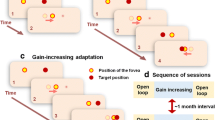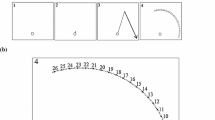Summary
Two monkeys were trained to track a continuously moving target using a joystick. One then had a cooling probe implanted in nucleus interpositus of the cerebellum ipsilateral to his tracking arm. The other had a cannula implanted in the ipsilateral cortex of the lateral cerebellum through which local anaesthetic could be infused. Both monkeys showed similar tracking deficits during temporary inactivation of the cerebellum. The main effects seen were an increase in the peak velocity of their intermittent corrective tracking movements, and a decrease in the accuracy of these movements. Linear regression analyses were undertaken of the peak velocity and amplitude of each corrective movement against a number of possible control signals (target velocity, target position, error, error velocity etc.). The initially strong correlation of the amplitude of each movement made with target velocity was severely reduced during cerebellar inactivation, and movement amplitude became better predicted by the error between target and joystick positions. The peak velocity of movements became more strongly correlated with movement amplitude and less correlated with target velocity than in the intact animal. These results are consistent with the hypothesis that intermittent tracking is achieved by the production of ‘primitive’ movements, that are then adjusted to the correct amplitude and velocity required to catch up with the moving target. Our findings suggest that the cerebellum may normally be responsible for these adjustments, using visual and memorised cues about the target. The velocity of each movement may be reduced, and its amplitude adjusted, by combining measures of the current error with estimates of target speed and direction. We conclude that the cerebellum has an inhibitory role in tuning movements during visuo-motor tasks and that optimal tuning using feedforward measurements of target motion cannot be made without it.
Similar content being viewed by others
References
Beaubaton D, Trouche E (1982) Participation of the cerebellar dentate nucleus in the control of goal directed movement in monkeys. Exp Brain Res 46: 127–138
Beppu H, Suda M, Tanaka R (1984) Analysis of cerebellar motor disorders by visually guided elbow tracking movement. Brain 107: 787–809
Brooks VB, Kozlovskaya IB, Atkin A, Horvath FE, Uno M (1973) Effects of cooling dentate nucleus on tracking-task performance in monkeys. J Neurophysiol 36: 974–995
Brooks VB (1979) Motor programs revisited. In: Talbott RE, Humphrey DR (eds) Posture and movement. Raven Press, New York, pp 13–49
Brooks VB (1983) Study of brain function by local, reversible cooling. Rev Physiol Biochem Pharmacol 95: 1–109
Craik KJW (1947) Theory of the human operator in control systems. I. The operator as an engineering system. Br J Psychol 38: 56–61
Demer JL, Robinson DA (1982) Effects of reversible lesions and stimulation of olivocerebellar system on vestibuloocular reflex plasticity. J Neurophysiol 47: 1084–1107
Gilman S, Carr S, Hollenberg J (1976) Kinematic effects of deafferentation and cerebellar ablation. Brain 99: 311–330
Holmes G (1917) The symptoms of acute cerebellar injuries due to gunshot injuries. Brain 40: 461–535
Holmes G (1939) The cerebellum of man. Brain 62: 1–30
Lisberger SG, Fuchs AF (1978) Role of primate flocculus during rapid behavioral modification of vestibular reflex. I. Purkinje cell activity during visually guided horizontal smooth-pursuit eye movements and passive lead rotation. J Neurophysiol 41: 733–763
Mano N-L, Yamamoto KI (1980) Simple spike activity of cerebellar Purkinje cells related to visually guided wrist tracking movement in the monkey. J Neurophysiol 43: 713–728
Miall RC, Weir DJ, Stein JF (1985) Visuomotor tracking with delayed visual feedback. Neuroscience 16: 511–520
Miall RC, Weir DJ, Stein JF (1986) Manual tracking of visual targets by trained monkeys. Behav Brain Res 20: 185–201
Navas F, Stark L (1968) Sampling or intermittency in hand controlled systems dynamics. Biophys J 8: 252–302
Poulton EC (1981) Human manual control. In: Handbook of physiology. The nervous system, Vol II (2). Springer, Berlin Heidelberg New York, pp 1337–1389
Snedecor GW, Cochran WG (1967) Statistical methods, 6th edn. Iowa University Press, Iowa
Stein JF (1978) Long loop motor control in monkeys: the effects of transient cooling of parietal cortex and of cerebellar nuclei during tracking tasks. Prog Clin Neurophysiol 4: 107–122
Stein JF (1985) Motor control. In: Coen C (ed) The Wolfson lectures. The brain. Oxford University Press, Oxford
Uno M, Kozlovskaya IB, Brooks VB (1973) Effects of cooling the interposed nuclei on tracking task performance in monkeys. J Neurophysiol 36: 996–1003
Woodworth RS (1899) The accuracy of voluntary movement. Psych Mono 3
Author information
Authors and Affiliations
Rights and permissions
About this article
Cite this article
Miall, R.C., Weir, D.J. & Stein, J.F. Visuo-motor tracking during reversible inactivation of the cerebellum. Exp Brain Res 65, 455–464 (1987). https://doi.org/10.1007/BF00236319
Received:
Accepted:
Issue Date:
DOI: https://doi.org/10.1007/BF00236319




